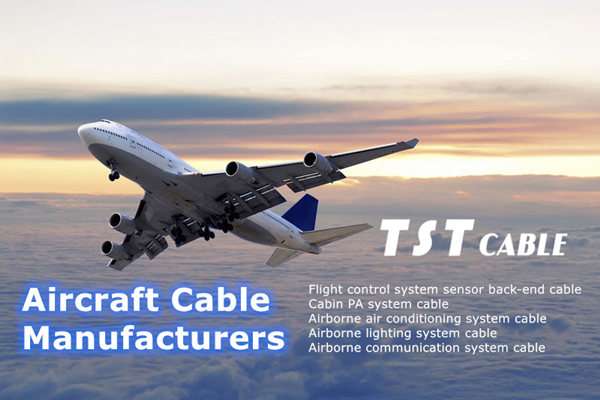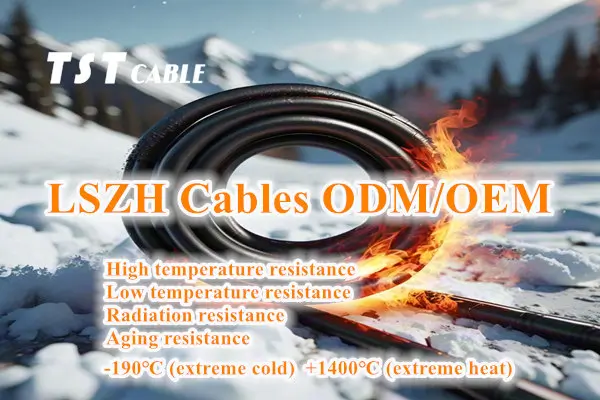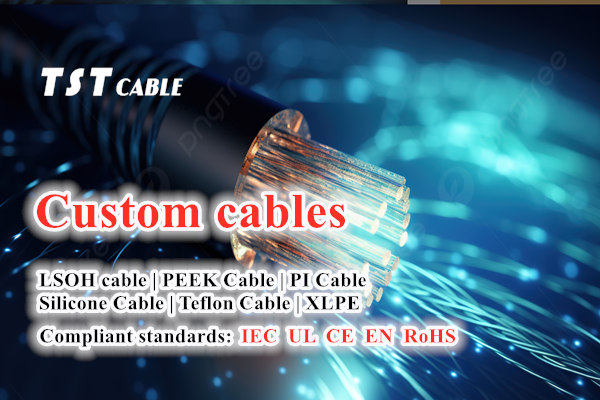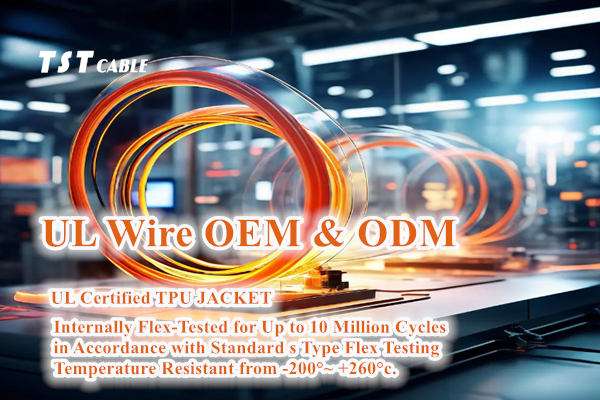Do you know what categories, models and flame retardant grades of low smoke halogen-free flame retardant cables are available? Low smoke halogen-free manufacturer TST CABLES will share with you a detailed cable knowledge popularization.
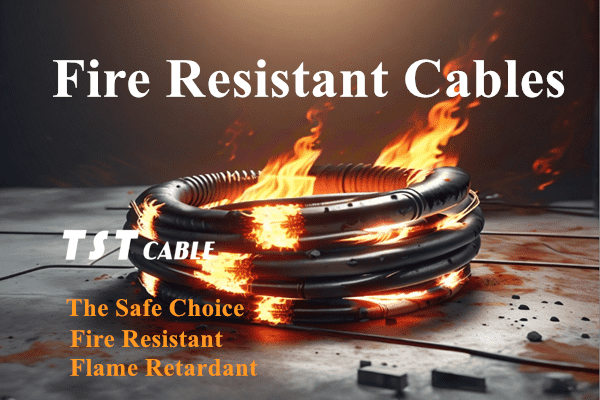
At present, the cable industry is accustomed to referring to flame retardant cables (FireRetardant cable), halogen-free low smoke cables (Low Smoke Halogen Free cable, LSOH cable) or low halogen low smoke cables (LowSmokeFume cable, LSF cable), fire-resistant cables (FireResistant) and other cables with certain fire resistance as fireproof cables.
Low smoke halogen-free flame retardant wires and cables produce very little smoke when burning, and contain no halogen or very little halogen, which can greatly reduce the harm to instruments, equipment and human body during fire. Therefore, they are widely used in crowded public places, such as high-rise buildings, large libraries, gymnasiums, explosion-proof command and toll buildings, stations, civil airports, passenger waiting rooms, key cultural relics protection units, subways, underground shops, etc.
Flame-retardant cable Classification of fireproof cables
(1) Flame retardant cable is characterized by delaying the spread of flames along the cable so that the fire does not expand. Due to its low cost, it is a cable variety widely used in fireproof cables. Whether it is a single cable or a bundled cable, the spread of flames can be controlled within a certain range when the cable is burned, so major disasters caused by cable fire and spread can be avoided, thereby improving the fire protection level of the cable line.
(2) Halogen-free low-smoke flame-retardant cable (LSOH cable)
The characteristics of halogen-free low-smoke cable are not only excellent flame retardant properties, but also the materials that constitute low-smoke halogen-free cable do not contain halogen, low corrosiveness and toxicity during combustion, and produce very little smoke, thereby reducing damage to the human body, instruments and equipment, and facilitating timely rescue in the event of a fire. Although halogen-free low-smoke flame-retardant cable has excellent flame retardancy, corrosion resistance and low smoke concentration, its mechanical and electrical properties are slightly worse than those of ordinary cables.
(3) Low halogen and low smoke flame retardant cable (LSF cable)
The hydrogen chloride emission and smoke concentration index of low halogen and low smoke flame retardant cable are between those of flame retardant cable and halogen-free low smoke flame retardant cable. The materials of low halogen (LowHalogen) cable also contain halogen, but the content is lower.
The characteristics of this cable are that it not only has flame retardant properties, but also releases less smoke and low hydrogen chloride when burning. This low halogen and low smoke flame retardant cable is generally made of polyvinyl chloride (PVC) as the base material, and is then processed with high-efficiency flame retardant, HCL absorber and smoke suppressant. Therefore, this flame retardant material significantly improves the combustion performance of ordinary flame retardant polyvinyl chloride materials.
(4) Fire-resistant cable (Fire Resistant wire) Fire-resistant cable can maintain normal operation for a certain period of time under flame combustion conditions and can maintain the integrity of the circuit (Circuit Intergrity). Fire-resistant flame-retardant cables produce less acidic gas smoke when burning, and their fire-resistant and flame-retardant properties are greatly improved. Especially when burning, accompanied by water spray and mechanical shock vibration, the cable can still keep the line running intact.
Some low-smoke halogen-free flame-retardant cable models
Low smoke zero halogen flame-retardant cables (Low Smoke Zero Halogen, LSZH or LSOH) have a variety of models in the international market. These cables are designed to reduce toxic smoke and halogenated gases produced during fires. The following are common low-smoke halogen-free flame-retardant cable models in the world:
TST CABLE Common Customized Low Smoke Zero Halogen Flame-retardant Cable Models
WDZ-BY, WDZN-BY (Chinese Standard): Low-smoke halogen-free flame-retardant fire-resistant wires and cables.
WDZ-BYJ (Chinese Standard): Suitable for flame-retardant polyethylene wires, suitable for wiring in buildings.
WDZ-KYJY (Chinese Standard): Suitable for flame-retardant polyethylene control wires, used for industrial control circuits.
WDZ-YJFY (Chinese standard): Applicable to irradiated cross-linked polyethylene cables with flame retardant properties, suitable for high-voltage power transmission.
WDZN-BYR (Chinese standard): Applicable to flame-retardant polyvinyl chloride soft wires, suitable for mobile devices.
WD-MYJY33 (Chinese standard): Applicable to high-voltage low-smoke halogen-free cables, used in special environments such as mines.
WDZB-YJY (international general): Applicable to flame-retardant and fire-resistant cross-linked power cables, widely used in construction, industry and other fields.
WDZB-YJ(F)E (international general): Applicable to flame-retardant and fire-resistant cables for power transmission.
WLZR-YWY (international general): Applicable to low-smoke halogen-free flame-retardant cables for industrial control circuits.
WLZR-YJWY (international general): Applicable to low-smoke halogen-free flame-retardant cables for power transmission.
WLZR-YY22 (international general): Applicable to low-smoke halogen-free flame-retardant cables for underground burial.
WDZN-YJV22, WDZ-YJY22 (international general): low smoke halogen-free flame retardant fire resistant cross-linked power cable.
WDZB-YJ(F)E22 (international general): suitable for flame retardant and fire resistant cables for power transmission with armor protection.
WDZB-YJY22 (international general): suitable for flame retardant and fire resistant cables for power transmission with armor protection.
WDZBN-YJY22 (international general): suitable for flame retardant and fire resistant cables for power transmission with armor protection.
WDZN-KYJY (international general): suitable for low smoke halogen-free flame retardant and fire resistant control cables.
WDZ-KYJY22 (international general): suitable for low smoke halogen-free flame retardant and fire resistant control cables with armor protection.
WDZN-KYJYP2 (international general): suitable for low smoke halogen-free flame retardant and fire resistant control cables with shielding layer.
WDZN-KYJYP23 (international general): suitable for low smoke halogen-free flame retardant and fire resistant control cables with shielding and armor protection.
WDZ-YJV (international general): suitable for low smoke halogen-free flame retardant cross-linked power cables.
WDZN-YJV (international general): suitable for low smoke halogen-free flame retardant and fire resistant cross-linked power cables.
WDZN-YJV22 (international general): suitable for low smoke halogen-free flame retardant and fire resistant cross-linked power cables with armor protection.
WDZ-YJY22 (international general): suitable for low smoke halogen-free flame retardant and fire resistant cross-linked power cables with armor protection.
International standards for low smoke halogen-free flame retardant cables
Low smoke halogen-free flame retardant cables need to comply with a series of international standards, including but not limited to:
·IEC 60332-3: Flame propagation test for bundled wires and cables.
·IEC 61034: Determination of smoke density generated when cables burn.
·EN 50575: Classification of cable performance in fire.
Selection basis of low-smoke halogen-free flame-retardant cable
When selecting low-smoke halogen-free flame-retardant cable, the following aspects should be considered:
· Application environment: Select the appropriate model according to the specific environment where the cable will be installed.
· Temperature range: Confirm whether the operating temperature range of the cable meets the actual needs.
· Flame retardant grade: Select the corresponding flame retardant grade according to the safety requirements of the application.
· Mechanical strength: If the cable needs to withstand mechanical stress, a cable with corresponding mechanical strength should be selected.
Low-smoke halogen-free flame-retardant cable is particularly widely used in crowded places such as public places, hospitals, schools, subways, etc., because it can reduce the generation of toxic smoke in fires and improve the safety of personnel escape. Choosing a suitable low-smoke halogen-free flame-retardant cable can greatly improve the safety of electrical systems.
2. Flame-retardant cable standards and grades
The main technical indicators of cable fire safety are the flame retardancy of CO2 cables, the density of smoke and the toxicity of gases. The US fire protection standards focus more on the first two issues, but Europe and the United States have completely different views on fire safety.
The traditional American concept is that the root cause of fire lies in the generation of carbon monoxide (CO) gas and the subsequent heat release during the conversion of CO to CO2 during combustion. Therefore, controlling the amount of heat released during combustion can reduce the harm of fire. Europe has traditionally believed that the amount of halogen acid (HCL) released during combustion, gas corrosiveness, smoke concentration and gas toxicity are the main factors that determine whether people can safely escape from the fire scene.
(1) IEC flame retardant grade
In order to evaluate the flame retardant performance of cables, the International Electrotechnical Commission has formulated three standards, IEC60332-1, IEC60332-2 and IEC60332-3. IEC60332-1 and IEC60332-2 are used to evaluate the flame retardant ability of a single cable when it is laid at an angle and vertically, respectively (corresponding to GB12666.3 and GB12666.4 standards in China). IEC60332-3 (corresponding to GB12666.5-90 in China) is used to evaluate the flame retardancy of bundled cables when they burn vertically. In comparison, the flame retardancy requirements for bundled cables when they burn vertically are much higher.
IEC60332-1/BS4066-1 Flame retardancy rating (Flame Test On Single Vertical Insulated Wires/Cables)
This is the flame retardancy standard for a single cable. The test stipulates that a 60cm long sample is fixed vertically in a metal box with an open front wall. A propane burner with a flame length of 175mm contacts the cable at a 45-degree angle from a position 450mm from the upper fixed end of the sample. If the damaged part of the sample is no more than 50mm away from the lower part of the fixed end, the test is passed.
IEC60332-3/BS4066-3 Flame retardant grade (Flame Test On Bunched Wires/Cables)
This is the flame retardant standard for bundled cables. The test stipulates that the cable sample with a length of 3.5m is fixed on the trapezoidal test frame with iron wire, and the number of samples is determined by the non-metallic materials required by different classifications. The sample is hung vertically on the back wall of the combustion furnace, and the air is introduced into the combustion furnace through the air inlet on the bottom plate.
The propane flat burner contacts the sample with a flame of 750℃. The sample must not burn within 20 minutes of vertical combustion under forced blowing (airflow discharge 5m3/minute, wind speed 0.9m/second), and the cable must extinguish itself within 2.5 meters of flame spread. IEC60332 is divided into Class A, Class B, Class C and Class D to evaluate the quality of flame retardant performance.
2) UL flame retardant standard
Any cable listed by UL can be printed with UL identification, fire rating and approval number if it meets a certain fire rating after testing and verification.
Plenum Flame Test/Steiner Tunnel Test
This is the highest requirement cable (Plenum Cable) in UL fire protection standard. The applicable safety standard is UL910. The test stipulates that multiple samples are laid on the horizontal air duct of the device and burned for 20 minutes with an 87.9KW gas Bunsen burner (300,000 BTU/Hr). The qualified standard is that the flame cannot extend beyond 5 feet from the front of the gas Bunsen burner flame. The maximum peak value of optical density is 0.5, and the maximum average density value is 0.15.
This CMP cable is usually installed in the air return pressurization system used by ventilation ducts or air handling equipment, and is recognized and adopted by Canada and the United States. FEP/PLENUM materials that meet the UL910 standard have better flame retardancy than low-smoke halogen-free materials that meet the IEC60332-1 and IEC60332-3 standards, and the smoke concentration is low when burning.
3) Trunk-level-CMR level (Riser Flame Test)
This is a commercial-grade cable (Riser Cable) in the UL standard, and the applicable safety standard is UL1666. The experiment stipulates that multiple specimens are laid on a simulated vertical axis and a specified 154.5KW gas Bunsen burner (527, 500BTU/Hr) is used for 30 minutes. The qualified standard is that the flame cannot spread to the upper part of a 12-foot-high room. Trunk-level cables have no smoke concentration specifications and are generally used for vertical and horizontal wiring on floors.
4) Commercial Grade-CM Grade (Vertical Tray Flame Test)
This is the commercial grade cable (General Purpose Cable) in the UL standard, and the applicable safety standard is UL1581. The experiment stipulates that multiple specimens are laid on a vertical 8-foot-high bracket and burned with a specified 20KW strip blowtorch (70,000 BTU/Hr) for 20 minutes. The qualified standard is that the flame cannot spread to the upper end of the cable and extinguish itself. UL1581 is similar to IEC60332-3C, except that the number of cables laid is different. There is no smoke concentration specification for commercial grade cables, and they are generally only used for horizontal wiring on the same floor, not for vertical wiring on the floor.
5) General Grade-CMG Grade (Vertical Tray Flame Test)
This is the general grade cable (General Purpose Cable) in the UL standard, and the applicable safety standard is UL1581. The test conditions of commercial grade and general grade are similar, and they are both approved for use in Canada and the United States. There is no smoke concentration specification for general-grade cables. They are generally only used for horizontal wiring on the same floor and should not be used for vertical wiring on the floor.
6) Home-grade CMX (Vertical Wire Flame Test)
This is the home-grade cable (Restricted Cable) in the UL standard. The applicable safety standards are UL1581 and VW-1. The test stipulates that the sample is kept vertical and burned with a test blowtorch (30,000TU/Hr) for 15 seconds, then stopped for 15 seconds, and repeated 5 times.
The qualified standard is that the residual flame cannot exceed 60 seconds, the sample cannot be burned by more than 25%, and the surgical cotton pad at the bottom cannot be ignited by falling objects. UL1581-VW-1 is similar to IEC60332-1, but the burning time is different. This grade also has no smoke or toxicity specifications and is only used in home or small office systems where a single cable is laid. This type of cable should not be laid in bundles and must be sheathed.
7) Smoke density, halogen content and toxicity level
IEC60754-1/BS6425-1 Determination of halogen gas content (Emission Of Halogens)
This is the specification for the release concentration of hydrogen chloride (HCL) in the IEC and BS standards. Halogens contain fluorine (Florine), chlorine (Chlorine), bromine (Bromine), iodine (Iodine) and the radioactive and volatile element astatine (Astatine), and the components are highly toxic. The experiment stipulates that when the combustion furnace is preheated to 800℃, a built-in 1.0g sample is pushed into the furnace, and the HCL is dissolved in water using the air flow emission rate, and then the halogen acid content of the aqueous solution is measured.
If the amount of halogen acid (HCL) released during the combustion of the cable material is less than 5mg/g, it can be called halogen-free cable (LSOH). If the halogen acid (HCL) release is greater than 5mg/g and less than 15mg/g, it can be called low halogen cable (LSF). (Click here to learn more about cable technology, a lot of dry goods are waiting for you) It is worth noting that the IEC60754-1 method cannot be used to determine materials with an HCL content of less than 5mg/g, that is, it cannot determine whether it is “halogen-free”. If you need to determine whether it is completely halogen-free, you can use the IEC60754-2 method to determine it.
8) IEC60754-2 Gas Acidity Measurement (Corrosivity)
This is the specification for the corrosiveness of combustion gases in the IEC standard. This test measures the acidity of halogen acid gases produced by materials during combustion. It is determined by the pH value and conductivity of the aqueous solution. The experiment stipulates that the combustion furnace is preheated to 800℃, a quartz tube with a built-in sample is pushed into the furnace, and the time is started at the same time.
In the first 5 minutes of the sample combustion, the pH value and electrical conductivity are measured every 1 minute, and every 5 minutes for the next 25 minutes. Generally, the pH value of halogen-free cable materials will be greater than 4.3, and the conductivity will be less than 10μs; the lower the pH value, the higher the acidity of the halogen acid gas of the material. It is worth noting that when the HCL content is greater than 2mg/g and less than 5mg/g (that is, it meets the requirements of IEC60754-1), the pH value of its aqueous solution is also less than 4.3, that is, it does not meet the requirements of IEC60754-2.
9) IEC61034-1/ASTME662 Smoke density (Emission of Smoke)
This is the specification for smoke density in IEC and ASTM standards. The experiment consists of a 3m3 cube and a photometric measurement system with a light source. Alcohol is filled in the rectangular groove as the combustion source. A blower with a power of 10-15m3/minute ensures that the smoke is evenly distributed on a windshield to prevent flame vortices from forming on the groove. When the alcohol burns, the recorder connected to the photoelectric power source records the amount of light attenuation.
Smoke density is measured by light transmittance. If the light transmittance reaches 60%, the cable material meets the low smoke standard. The higher the light transmittance, the less smoke the material releases when it burns.
10) ISO4589-2/BS2863 Oxygen Index (Oxygen Index LOI)
This is the specification for oxygen index in ISO and BS standards. It means that at room temperature, when the oxygen content of the air is greater than this oxygen index, the material will burn immediately. The higher the oxygen index value, the more flame retardant the material. If the oxygen index of a material is 21%, it means that the material will automatically burn at normal room temperature. At normal room temperature, the oxygen content of air is 21%. The oxygen index of general flame-retardant cables is greater than 33%.
11) ISO4589-3/BS2782.1 Temperature Index (TemperatureIndexTI)
This is the specification for temperature index in ISO and BS standards. The oxygen index of a material will decrease as the temperature rises. When the air temperature rises and the oxygen index of the material drops to 21%, the material will automatically burn. This temperature is called the temperature index.
For example, the oxygen index of coal at room temperature is 50%, but when the temperature rises to 150℃, the oxygen index will drop to 21%, and the material will also burn immediately. The temperature index of the material is 150℃. The temperature index of general flame-retardant cables is greater than 250℃.
12) NES713 Toxicity Index
This is the toxicity specification for gases produced when cable materials burn in the British Naval Engineering NES standard. Toxicity refers to a property that causes damage to the structure of an organism or functional disorder. The toxicity index refers to the sum of the toxicity of all gases produced when the material burns.
The experiment stipulates that the combustion furnace is preheated to 800°C, and the toxic substances contained in the cable material will be burned separately. Each toxic gas is collected using the airflow emission rate, and then the content of each toxic substance is calculated through chemical analysis. This index is expressed in numbers. The larger the toxicity index, the higher the toxicity of the gas released by this material. The toxicity index of general halogen-free cable materials is less than 5.
It is worth noting that low-smoke halogen-free materials will also produce toxic CO when they burn. If the material contains P, N, and S, more toxic gases will be generated. Therefore, halogen-free cables cannot be called non-toxic cables, but should be called low-toxic cables.
CM, CMR and CMP cables need to pass strict UL fire protection standards, so the cable materials used are mostly halogen-containing. CM and CMR cables are generally based on polyvinyl chloride (PVC), which contains chlorine; CMP cables are generally based on Teflon polytetrafluoroethylene (FEP), which contains fluorine.
The gas toxicity produced by such halogen-containing cables is several times greater than that of halogen-free cables, which poses a great hidden danger in fire safety and may cause most casualties at the fire scene to die of suffocation by poisonous gas instead of being burned to death.
13) IEC fire resistance grade
Fire-resistant cables refer to cables that can maintain normal operation for a certain period of time under the condition of flames, that is, maintain the integrity of the circuit (Circuit Integrity). In order to evaluate the fire resistance performance of cables, the International Electrotechnical Commission and the British Electrotechnical Commission have respectively formulated two standards, IEC331 and BS6387. In comparison, BS6387 has much higher requirements for fire resistance than IEC331.
14) IEC60331 flame retardant grade In IEC60331-1999, the fire supply temperature requirement is 750℃/3h, which means that the horizontal burning of 300 volts at 750℃ for 3 hours without breakdown.
15) BS6387 flame retardant grade
BS6387 requires horizontal burning test, water spray test and mechanical shock and vibration burning test. The horizontal burning test is A-level 650℃/3h, B-level 750℃/3h, C-level 950℃/3h and S-level 950℃/3min.
Grade A means that the horizontal burning of 300 volts at 650℃ for 3 hours without breakdown; Grade B means that the horizontal burning of 300 volts at 750℃ for 3 hours without breakdown; Grade C means that the horizontal burning of 300 volts at 950℃ for 3 hours without breakdown; Grade S means that the horizontal burning of 300 volts at 950℃ for 3 minutes without breakdown.
The water spray combustion test is divided into W level, which means that the voltage of 300 volts is applied to burn for 15 minutes and then spray water to burn for 15 minutes without breakdown. The impact vibration combustion test is divided into X level 650℃/15min, Y level 750℃/15min and Z level 950℃/15min. X level means that 300 volts are applied at 650℃ while burning and mechanical shock and vibration are applied every 30 seconds for 15 minutes without breakdown; (Click here to learn more about cable technology, a lot of dry goods are waiting for you) Y level means that 300 volts are applied at 750℃ while burning and mechanical shock and vibration are applied every 30 seconds for 15 minutes without breakdown; Z level means that 300 volts are applied at 950℃ while burning and mechanical shock and vibration are applied every 30 seconds for 15 minutes without breakdown. The highest level model required by BS6387 is CWZ.
Cooperate with TST CABLES to customize high-quality LSOH/LSZH/LSF cables
In modern buildings and industrial facilities, safety is always the primary goal. Low smoke halogen-free flame retardant cables have become the first choice for many high-end projects with their excellent safety performance. Using advanced low smoke halogen-free materials, our cables can significantly reduce the generation of toxic smoke when a fire occurs, and maximize the protection of personnel’s lives. Not only that, these cables also have excellent flame retardant properties, which can effectively delay the spread of fire and win precious time for emergency evacuation. Whether it is a high-rise building, subway station or hospital school, choosing low smoke halogen-free flame retardant cables is choosing a peace of mind and reliability. We are well aware of the importance of every detail. From material selection to production process, every step strictly follows international standards to ensure that every cable can play a key role at a critical moment.
If you have customized low smoke halogen-free cables, flame retardant cables, coaxial cables, UL cables, Teflon wires, armored wires, industrial cables, power cables, control cables and other products, and need further technical support or cable solutions, you can always send an email to the professional cable engineer of TST cable manufacturer (email: lixiangchao@testeck.com, please state your country, your industry, and your needs in the email, and we can also provide you with free samples)
Also available in:
English


